How to Wash a Backpack: Expert Tips for a Fresh and Clean Look
Ensuring a clean backpack isn’t just about appearance – it’s about hygiene and longevity. Learn the essential How to Wash a Backpack techniques to eliminate germs, odors, and stains while preserving its functionality and style.
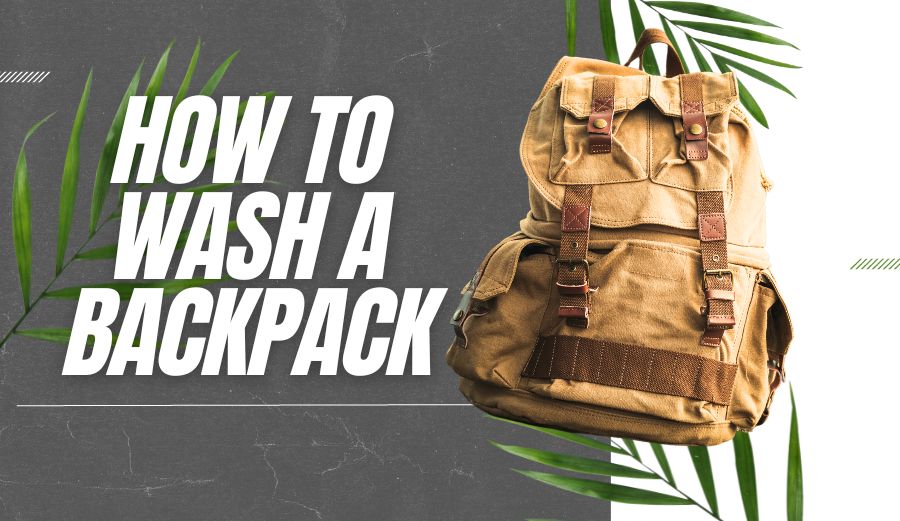
Have you ever wondered if your trusty backpack could talk what tales of spilled coffee, forgotten snacks, and sweat-soaked gym clothes it would share? Fear not!
Discover the secret behind maintaining a pristine backpack with our ultimate guide on How to Wash a Backpack. Unravel the mysteries of cleanliness, durability, and style in just a few simple steps.
Table of Contents
ToggleUnderstanding Backpack Cleaning Basics

Backpacks, faithful partners on life’s adventures, frequently endure the aftermath of spills, overlooked residues, and even our perspiration. The accumulation of daily experiences can leave them looking tired and smelling less than fresh. But fear not, for a bit of cleaning goes a long way.
Let’s delve into why backpacks get dirty in the first place – from that coffee mishap to the remnants of yesterday’s snack – and explore the invaluable benefits of giving them a regular cleaning routine.
Why Backpacks Get Dirty
Spills are an inevitable part of life – that morning coffee jolt, the sneaky leak of a pen, or the traces of a midday snack. As we go about our busy lives, it’s no surprise that our trusty backpacks carry the marks of these daily mishaps. Add forgotten items like crumbs, dirt, and the occasional sticky trap, and your backpack becomes a canvas of life’s unpredictable moments.
The Sweaty Reality
Backpacks worn during gym sessions, outdoor adventures, or even sweltering commutes can become unwitting repositories for sweat and odor. The human body’s natural cooling mechanism can turn into an unpleasant residue that clings to fabrics. This phenomenon, coupled with the warmth inside the backpack, creates an ideal environment for bacteria to thrive.
Benefits of Regular Backpack Cleaning:
- Hygiene First: A clean backpack ensures you’re not carrying germs and odors, promoting personal hygiene.
- Longevity: Regular cleaning prevents dirt buildup, which can damage fabrics and zippers over time, extending the life of your beloved backpack.
- Style Renewed: A fresh, clean backpack doesn’t just feel better to use – it looks better, too, enhancing your overall appearance.
- Preserving Contents: By cleaning your backpack, you also safeguard the items you carry within from dirt, spills, and potential damage.
In backpacks, a little cleaning awareness goes a long way. Understanding the reasons behind their dirtiness and the perks of keeping them clean sets the stage for the thorough cleaning methods we’ll delve into. So, are you ready to unveil the secrets to backpack freshness? Let’s confidently delve into “How to Wash a Backpack.”
Preparing for a Successful Clean
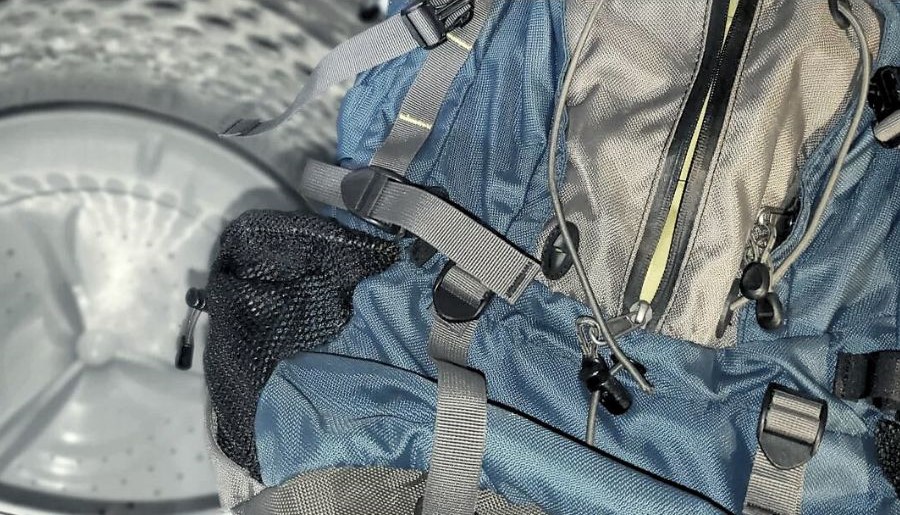
Before embarking on your backpack cleaning journey, taking preparatory steps can make all the difference in achieving optimal results. Let’s explore the essential actions that set the stage for a successful cleaning process:
1. Decoding Care Labels: Take advantage of this crucial step! Care labels are your backpack’s way of communicating its preferred cleaning method. Whether it’s a gentle hand wash or a machine-friendly routine, heed these instructions to ensure the safety and longevity of your backpack’s materials.
2. Empty and Organize: Imagine your backpack as a blank canvas ready for transformation. Empty its contents completely, leaving no pocket unexplored. As you do, take the opportunity to organize the items you’ve been carrying. Discard any unnecessary debris, clear out forgotten crumbs, and set aside soiled items for cleaning or replacement.
3. Assemble Your Arsenal: Just as a painter needs the right brushes, you’ll need the appropriate tools to restore your backpack’s vibrancy. Soft-bristled brushes, old toothbrushes, and handheld vacuums are your allies against stubborn dirt and dust. Equip yourself with these cleaning companions to ensure a thorough and effective cleaning session.
A successful backpack cleaning endeavor is about more than just scrubbing away dirt; it’s a carefully orchestrated process that begins with preparation. By understanding care labels, organizing your backpack’s contents, and gathering the right tools, you’re laying the foundation for a truly transformative cleaning experience. So, as you embark on this cleaning odyssey, remember that a prepared start leads to an immaculate finish.
Hand Washing Techniques for Different Backpacks
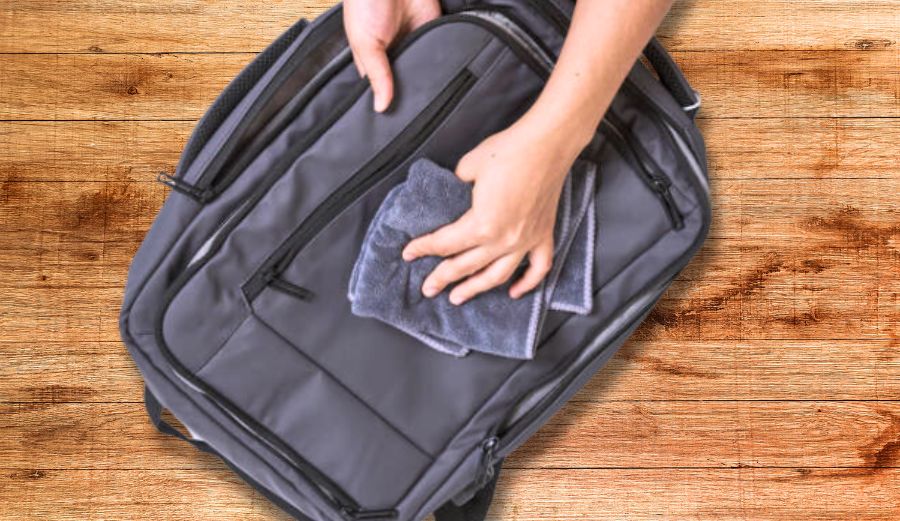
When it comes to tender care and precision cleaning, hand washing emerges as the go-to technique for a variety of backpacks. Let’s explore why and uncover the detailed steps that transform this method into a spa day for your trusty companion:
1. The Perfect Hand Wash: Hand washing is your ally when dealing with delicate or embellished backpacks that require extra attention. It’s the recommended route for leather-trimmed, embroidered, or adorned bags that might not fare well in the whirlwind of a washing machine.
2. Step-by-Step Hand Washing: Here’s how to pamper your backpack with a meticulous hand wash:
- Step 1: Detachable Parts and Loose Threads: Remove detachable components like straps, belts, or metal frames. Address loose threads that could snag during the cleaning process.
- Step 2: Target Stubborn Stains: Armed with a mild detergent mixed with water, target stubborn stains with gentle spot treatment. Allow the solution to sit briefly, letting it work its magic.
- Step 3: Gentle Scrubbing: Employ the soft touch of a soft-bristled brush or sponge to gently scrub the surface of your backpack. Concentrate on areas where dirt and grime have taken up residence.
- Step 4: Rinsing and Patting: Once your backpack gleams with renewed freshness, thoroughly rinse it to bid farewell any lingering detergent. Afterward, gently patting removes excess moisture, treating your bag with the care it deserves.
- Step 5: The Art of Air-Drying: Embrace proper air-drying techniques, keeping your backpack upside down to promote even drying. Avoid direct sunlight, which can fade colors and damage materials.
3. Gentle Caution for Special Backpacks: While hand washing showers your backpack with tenderness, it’s essential to exercise extra caution when dealing with leather, embroidered, or adorned varieties. These distinct materials call for a mindful approach to ensure they emerge from the process unscathed and stunningly rejuvenated.
Remember, hand washing stands as the pinnacle of care when your backpack deserves a royal treatment that only hands can provide. By following these steps with meticulous attention, you’re preserving the integrity and charm of your bag while ushering in a new era of spotless elegance.
Mastering Machine Washing for Optimal Results
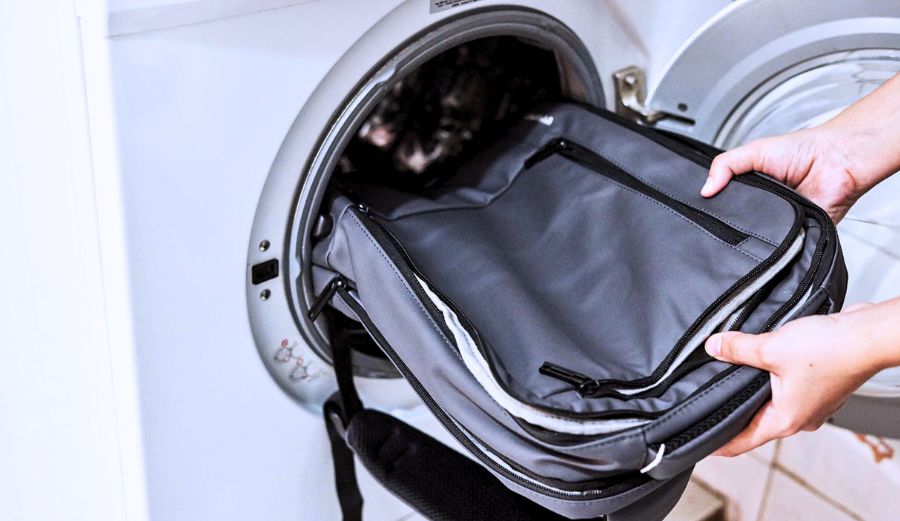
Unveiling the art of machine washing is a game-changer when dealing with hardy backpack companions like nylon and canvas. Dive into this method that blends convenience and thoroughness to achieve backpack brilliance:
1. Knowing When to Embrace the Machine: Machine washing comes to the rescue when your backpack’s rugged nature, think nylon or canvas, beckons for a deep yet effortless cleanse. Say goodbye to uncertainty; this method is a trusted choice for these resilient materials.
2. Step-by-Step Machine Washing: Unlock the secrets to a successful machine wash that leaves your backpack rejuvenated:
- Step 1: Detachable Parts and Loose Threads: Begin by parting ways with detachable elements like straps and belts. Tuck away any loose threads that could tangle during the wash cycle.
- Step 2: Tackling Persistent Stains: Give those stubborn stains a little pre-treatment love before the wash. Apply a mild detergent to the affected areas, allowing it to work its magic before the wash.
- Step 3: Protective Measures with Bags: Slide your backpack into a laundry bag or pillowcase, safeguarding it from friction-induced wear and tear during the machine’s spin.
- Step 4: Optimal Detergent and Cycle: Choose a gentle, preferably fragrance-free detergent to ensure your backpack’s colors and fabrics remain unscathed. Opt for a delicate cycle that treats your bag with the care it deserves.
- Step 5: Post-Wash Pampering: Once the machine’s rhythmic cleansing dance is complete, gently pat away excess moisture using an old towel. This step eases the air-drying process and prevents water spots.
3. Handling Zipper, Strap, and Machine Concerns: You’ve got questions; we’ve got answers. Concerns about zippers catching, straps tangling, and potential machine damage are natural. Fear not; our guide addresses these worries, ensuring your backpack emerges from the machine unharmed and ready to shine.
Machine washing may sound daring, but with the right approach, it’s a practical and hassle-free route to a spotless backpack. By following these steps, you’re taking the guesswork out of machine washing and ushering in a new era of cleanliness and convenience.
A Clear View on Cleaning Transparent Backpacks
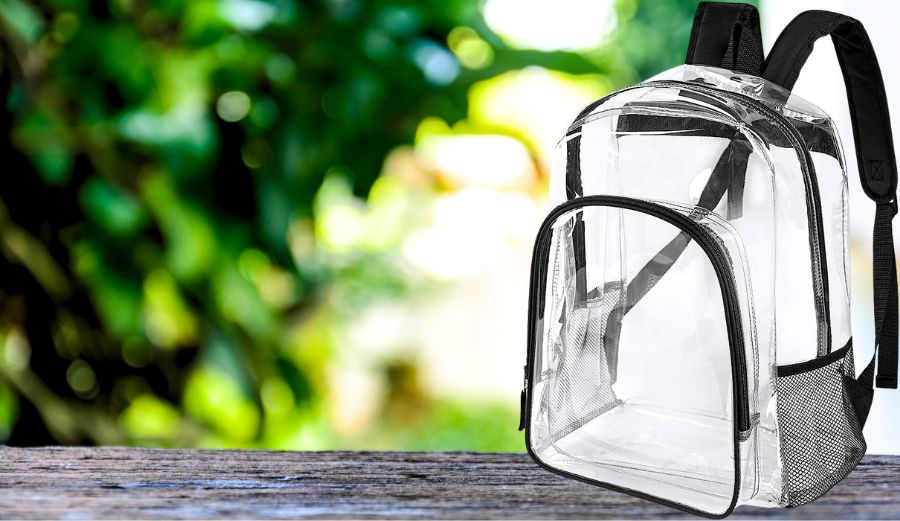
Transparent backpacks add a modern touch to your style, but maintaining their pristine look requires a unique approach. Let’s uncover the nuances of cleaning these see-through companions and achieve a sparkling clarity that’s second to none:
1. Embracing the Transparency Challenge: Transparent backpacks may reveal your belongings but also showcase every dirt and smudge. Cleaning them demands precision and attention to detail, considering their visibility amplifies even the slightest imperfection.
2. Step-by-Step Cleaning for Crystal-Clear Beauty: Elevate your transparent backpack’s allure with these meticulous cleaning steps:
- Step 1: Clearing Debris and Dirt: Begin by emptying your transparent backpack and shaking out any debris or dirt. Every corner deserves attention, so ensure no nook or cranny is overlooked.
- Step 2: Soothing Soapy Cleansing: Opt for mild soapy water mixed with lukewarm water. Gently scrub the surfaces using a soft washcloth, being mindful not to scratch the transparency. This step targets smudges and marks without compromising the clear finish.
- Step 3: Rinse and Repeat: Rinse your backpack thoroughly to remove any lingering soap residue. A clear pack deserves a clear rinse! Use clean water and ensure all soap is washed away to prevent streaks.
- Step 4: Nailing Stubborn Spots: When faced with stubborn spots, enter the realm of creativity. Try a special tip: apply non-acetone nail polish remover on a cotton pad and gently rub the area. This technique delicately tackles persistent blemishes.
- Step 5: The Art of Air-Drying: Master the art of air-drying for that coveted crystal-clear effect. Ensure your transparent backpack is completely dry before using it again, as moisture can mar its pristine look.
Transparent backpacks offer a glimpse into your world, but a flawless view demands proper maintenance. By following these steps designed to preserve their clarity, you ensure that your transparent backpack remains stylish and turns heads for all the right reasons.
The Art of Maintenance and Prevention
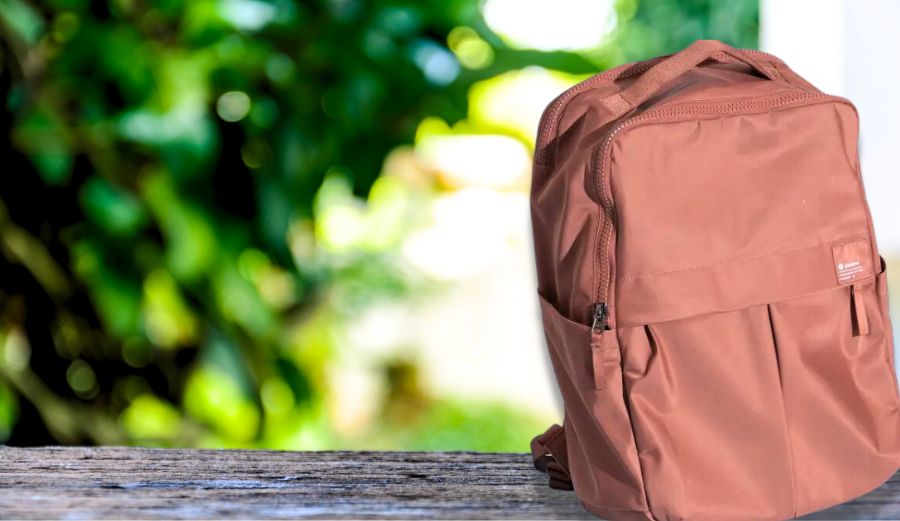
Like any masterpiece, maintaining the allure of your backpack requires ongoing care. Discover how regular maintenance serves as a shield against arduous cleaning, and uncover simple yet effective prevention techniques to keep dirt and odors at bay:
1. The Power of Routine Maintenance: Regular care saves you from the woes of extensive cleaning. Just as a painter maintains their brushes, your backpack thrives when given consistent attention. A stitch in time, as they say, prevents the need for major repairs later.
2. Preventing Dirt and Odors: Bid farewell to unnecessary dirt and unpleasant odors with these simple yet impactful prevention strategies:
- Regular Emptying: Make it a habit to empty your backpack after each use. This prevents forgotten items from accumulating and causing potential messes.
- Protective Covers: Consider using protective covers, especially during heavy usage. These shields act as barriers against spills, dirt, and daily wear.
- Airing It Out: Allow your backpack to breathe by leaving it in a well-ventilated area. This practice curbs moisture buildup and keeps odors at bay.
- Organized Contents: Organize your belongings within your backpack. Use pouches or compartments to separate items and minimize the chances of spills or cross-contamination.
- Regular Spot Checks: A quick glance every so often can alert you to any developing issues. Promptly address minor stains or spills before they have a chance to set.
3. Preserving Your Backpack’s Shine: Just as a masterpiece retains its brilliance with careful attention, your backpack flourishes when you prioritize maintenance. By emptying, protecting, and airing out, you’re proactively safeguarding its charm and extending its life span.
Prevention isn’t just a proactive measure; it’s a testament to your commitment to keeping your backpack at its best. Regular maintenance transforms your bag from a mere accessory into a reliable companion that stands the test of time, always ready to accompany you on your adventures.
FAQs and Expert Tips
Navigating the realm of backpack cleaning and care comes with questions and insights only experts can provide. Let’s shed light on these queries and unveil expert tips from backpack manufacturers and seasoned cleaning professionals:
Frequently Asked Questions:
Q1: How often should I wash my backpack?
A: Washing your backpack once or twice a year is ideal. However, more frequent cleaning might be necessary if you’re using it as a gym bag or for outdoor activities.
Q2: How long does a backpack dry after washing?
A: A backpack can take a day or more to fully dry due to the dense materials. Warmer months speed up the drying process and using a towel to absorb excess moisture aids in quicker drying.
Q3: Can a backpack shrink in the dryer?
A: Subjecting a backpack to the dryer can lead to shrinkage. It’s recommended to always air-dry your bags to prevent any damage to the materials.
Expert Tips:
Tip 1: Kali Shager from Land’s End advises using a clean makeup brush for hard-to-remove dirt. Its soft bristles help loosen debris without harming the fabric.
Tip 2: Use non-acetone nail polish remover on cotton pads for transparent backpacks to gently tackle stubborn spots. Apply on the exterior and interior, then wipe clean with a fresh place.
Tip 3: Protect your backpack by placing it in a laundry bag or pillowcase during machine washing. This minimizes the risk of straps or zippers getting caught or tangled.
Tip 4: When air-drying, hang your backpack upside down to ensure thorough drying and prevent water from pooling in pockets or crevices.
Tip 5: Hand washing is recommended for specialized backpacks like leather-trimmed or embroidered ones to maintain their unique features.
Arming yourself with expert insights and answers to common questions elevates your backpack care game. These tidbits of wisdom, sourced from those who understand the intricacies of materials and cleaning, ensure your backpack remains pristine for the long haul.
Wrap Up: Backpack Brilliance Achieved
In the journey of “How to Wash a Backpack,” we’ve uncovered a world of care, attention, and methods that transform your trusty companion into a beacon of brilliance. Let’s recap the key takeaways that empower you to maintain a spotless, fresh, and functional backpack:
1. Tailored Techniques: Whether hand or machine washing, each technique has its moment to shine. Hand washing offers precision for delicate or adorned backpacks, while machine washing suits the ruggedness of nylon and canvas.
2. Preventive Wisdom: Regular maintenance emerges as your armor against intensive cleaning. Emptying, using protective covers, and organizing your contents curtail dirt and odors from taking root.
3. Expert Guidance: Insights from manufacturers and cleaning professionals offer a compass to navigate questions and concerns. These expert tips ensure your backpack care aligns with industry wisdom.
Your backpack is more than just an accessory; it reflects your adventures, style, and personality. By mastering the art of backpack cleaning, you ensure it remains an impeccable companion on all your journeys.
We invite you to share your backpack cleaning triumphs. Let us know how our guide has helped you achieve backpack brilliance. From conquering stubborn stains to reviving worn materials, your success stories become a testament to the power of care and knowledge. Here’s to clean, fresh, and brilliantly maintained backpacks that journey with you every step of the way.
